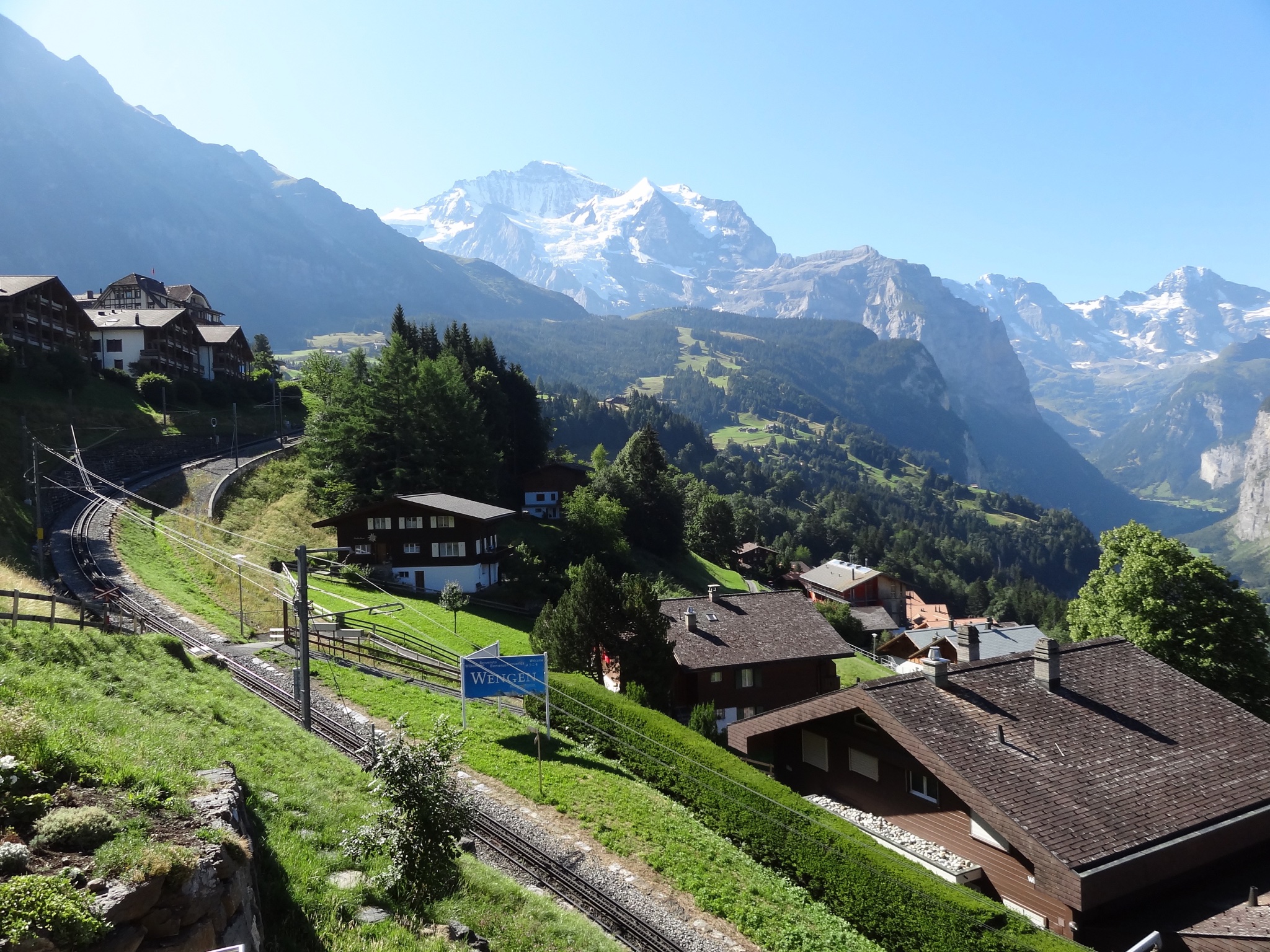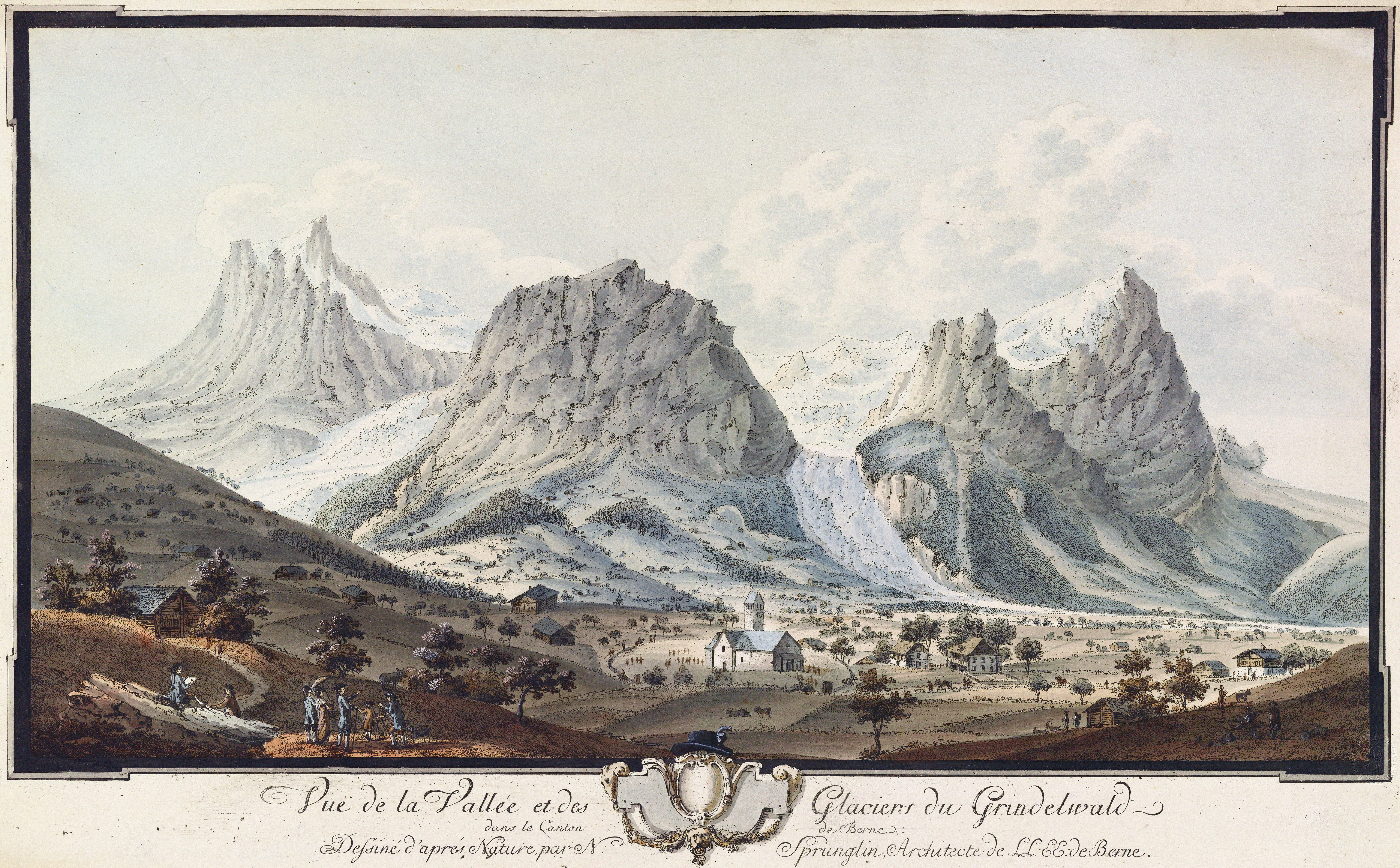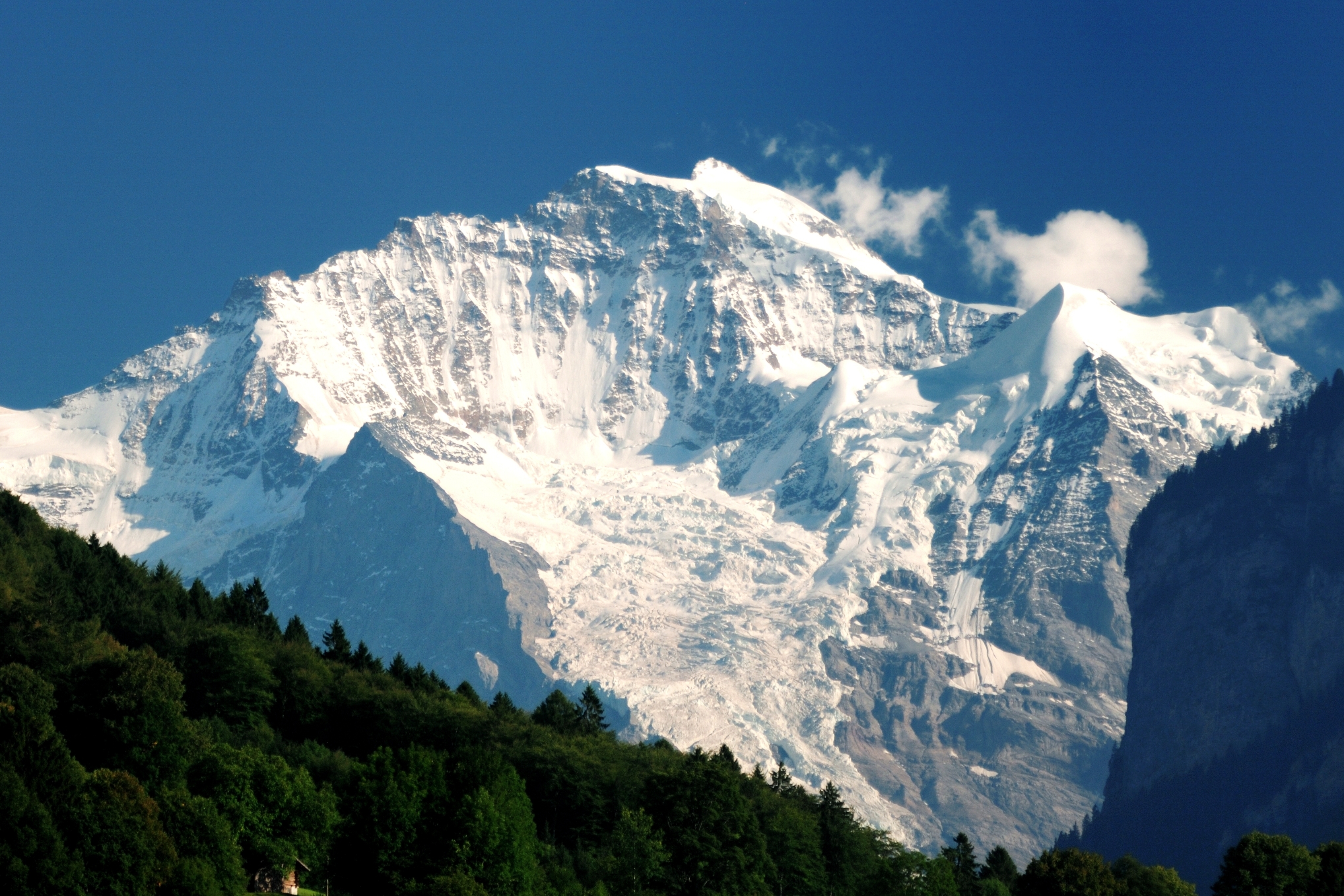|
Wengernalp
The Wengernalp is an alpine meadow at an elevation of 1874 m, above Wengen in the Bernese Oberland of Switzerland. It lies on the southern slopes of the Lauberhorn, just below Kleine Scheidegg, a mountain pass connecting the valleys of Lauterbrunnen and Grindelwald. The pass is traversed by a railway bearing its name, the Wengernalp Railway (WAB) with a railway station serving the locality, the Wengernalp station. The Wengernalp is a popular for its views over the giants of the Bernese Alps. In fact, it directly faces the huge northern walls of the Jungfrau, Mönch and Eiger, across the extremely narrow Trümmelbach valley. In 1841 the hotel '' De la Jungfrau'' was opened; it was later rebuilt after a fire in 1865. In winter, the Wengernalp (and Kleine Scheidegg) are part of a large ski area. Amongst the many historical, famous people who have spent holidays on the Wengernalp are Felix Mendelssohn Bartholdy, Richard Wagner and Peter Tchaikovsky. See also *Alps References *Sw ... [...More Info...] [...Related Items...] OR: [Wikipedia] [Google] [Baidu] |
Wengernalp Railway
The Wengernalp Railway (german: Wengernalpbahn, WAB) is a long rack railway line in Switzerland. It runs from Lauterbrunnen to Grindelwald via Wengen and Kleine Scheidegg, making it the world's longest continuous rack and pinion railway. The name refers to the alpine meadow of Wengernalp, above Wengen. The line is normally operated in two sections, with trains from either direction terminating at Kleine Scheidegg. At the latter station, most passengers transfer to the Jungfrau Railway for the continuation of the journey to the highest railway station in Europe at Jungfraujoch. There are generally no roads to Wengen/Mürren, and the train is the main access. The line is owned by the ''Wengernalpbahn AG'', a subsidiary of the ''Jungfraubahn Holding AG'', a holding company that also owns the Jungfraubahn and Bergbahn Lauterbrunnen–Mürren, Harderbahn, and Firstbahn. Through that holding company it is part of the ''Allianz - Jungfrau Top of Europe'' marketing alliance, which ... [...More Info...] [...Related Items...] OR: [Wikipedia] [Google] [Baidu] |
Wengernalp Railway Station
Wengernalp is a request stop railway station in the municipality of Lauterbrunnen in the Swiss canton of Bern. The station is on the Wengernalpbahn (WAB), whose trains operate from Lauterbrunnen to Kleine Scheidegg via Wengen. It takes its name from the alpine meadow of Wengernalp The Wengernalp is an alpine meadow at an elevation of 1874 m, above Wengen in the Bernese Oberland of Switzerland. It lies on the southern slopes of the Lauberhorn, just below Kleine Scheidegg, a mountain pass connecting the valleys of Lauterbru ... on which it is situated. The station is served by the following passenger trains: References External links * Railway stations in the canton of Bern {{Switzerland-railstation-stub ... [...More Info...] [...Related Items...] OR: [Wikipedia] [Google] [Baidu] |
Wengen
Wengen () is a mountain village in the Bernese Oberland of central Switzerland. Located in the canton of Bern at an elevation of above sea level, it is part of the Jungfrauregion and has approximately 1,300 year-round residents, which swells to 5,000 during summer and to 10,000 in the winter. Wengen hosts the classic Lauberhorn ski races of the FIS Alpine Ski World Cup in January. History Wengen was first mentioned in official documents in 1268, and the origin of the name is unknown. Primarily an alpine farming community, the village began to be visited by tourists in the early 19th century. Mary and Percy Bysshe Shelley's ''History of a Six Weeks' Tour'' and Byron's '' Manfred'', in which the scenery of the area is described, were published in 1817. This literature became the advent of the modern tourism industry for the village. Felix Mendelssohn, to whom there is a memorial above the village, also visited in the early nineteenth century. Guesthouses and hotels began to b ... [...More Info...] [...Related Items...] OR: [Wikipedia] [Google] [Baidu] |
Kleine Scheidegg
The Kleine Scheidegg ( en, Little Scheidegg) is a mountain pass at an elevation of , situated below and between the Eiger and Lauberhorn peaks in the Bernese Oberland region of Switzerland. The name means "minor watershed", as it only divides the two arms of the Lütschine river, both converging at Zweilütschinen, while the nearby Grosse Scheidegg divides the Lütschine from the Rychenbach stream. The pass is traversed by a walking trail and the Wengernalp Railway, which both connect the villages of Grindelwald with Lauterbrunnen, passing through Wengen between the pass summit and Lauterbrunnen. In winter, Kleine Scheidegg is the centre of the ski area around Grindelwald and Wengen. In summer, it is a popular hiking destination, and is one of the passes crossed by the Alpine Pass Route between Sargans and Montreux. The Jungfrau Marathon, a mountain race that takes place every year in early September, ends at Kleine Scheidegg. The Kleine Scheidegg railway station is sited at th ... [...More Info...] [...Related Items...] OR: [Wikipedia] [Google] [Baidu] |
Lauterbrunnen
, neighboring_municipalities= Aeschi bei Spiez, Blatten (Lötschen) (VS), Fieschertal (VS), Grindelwald, Gündlischwand, Kandersteg, Lütschental, Reichenbach im Kandertal, Saxeten, Wilderswil , twintowns = } Lauterbrunnen is a village and Municipalities of Switzerland, municipality in the Interlaken-Oberhasli (administrative district), Interlaken-Oberhasli administrative district in the Cantons of Switzerland, canton of Canton of Bern, Bern in Switzerland. The municipality comprises the other villages of Wengen, Mürren, Gimmelwald, Stechelberg and Isenfluh, as well as several other hamlets. The population of the village of Lauterbrunnen is less than that of Wengen, but larger than that of the others. The municipality comprises the Lauterbrunnen Valley (german: Lauterbrunnental), located at the foot of the Bernese Alps. It is notably overlooked by the Eiger, Mönch and Jungfrau and many other high peaks. The valley, drained by the White Lütschine, comprehends the Soustal, t ... [...More Info...] [...Related Items...] OR: [Wikipedia] [Google] [Baidu] |
Grindelwald
Grindelwald is a village and Municipalities of Switzerland, municipality in the Interlaken-Oberhasli (administrative district), Interlaken-Oberhasli administrative district in the Cantons of Switzerland, canton of Bern (canton), Berne. In addition to the village of Grindelwald, the municipality also includes the settlements of Alpiglen, Burglauenen, Grund, Itramen, Mühlebach, Schwendi, Tschingelberg and Wargistal. Grindelwald village is located at AMSL, above sea level. Mentioned for the first time in 1146, it has become a major tourist destination of both Switzerland and the Alps since the golden age of alpinism in the 19th century. It is notably overlooked by the section of the Bernese Alps from the Wetterhorn to the Eiger, making up a huge natural barrier. Together with the adjacent valley of Lauterbrunnen, the valley of Grindelwald forms part of the Jungfrau Region of the Bernese Oberland, between Interlaken and the main crest of the Bernese Alps. Similarly to Lauterbrunnen, ... [...More Info...] [...Related Items...] OR: [Wikipedia] [Google] [Baidu] |
Jungfrau
The Jungfrau ( "maiden, virgin"), at is one of the main summits of the Bernese Alps, located between the northern canton of Bern and the southern canton of Valais, halfway between Interlaken and Fiesch. Together with the Eiger and Mönch, the Jungfrau forms a massive wall of mountains overlooking the Bernese Oberland and the Swiss Plateau, one of the most distinctive sights of the Swiss Alps. The summit was first reached on August 3, 1811, by the Meyer brothers of Aarau and two chamois hunters from Valais. The ascent followed a long expedition over the glaciers and high passes of the Bernese Alps. It was not until 1865 that a more direct route on the northern side was opened. The construction of the Jungfrau Railway in the early 20th century, which connects Kleine Scheidegg to the Jungfraujoch, the saddle between the Mönch and the Jungfrau, made the area one of the most-visited places in the Alps. Along with the Aletsch Glacier to the south, the Jungfrau is part of the Jungf ... [...More Info...] [...Related Items...] OR: [Wikipedia] [Google] [Baidu] |
Bernese Alps
, topo_map= Swiss Federal Office of Topography swisstopo , photo=BerneseAlps.jpg , photo_caption=The Eiger, Mönch, and Jungfrau , country= Switzerland , subdivision1_type=Cantons , subdivision1= , parent= Western Alps , borders_on= , length_mi= , length_orientation= , width_mi= , width_orientation= , geology= , orogeny= , highest=Finsteraarhorn , elevation_m=4274 , range_coordinates= , coordinates= , map_image=Berner Alpen.png , map_caption=Map of Bernese Alps and their location in Switzerland (red) The Bernese Alps (german: Berner Alpen, french: Alpes bernoises, it, Alpi bernesi) are a mountain range of the Alps, located in western Switzerland. Although the name suggests that they are located in the Berner Oberland region of the canton of Bern, portions of the Bernese Alps are in the adjacent cantons of Valais, Fribourg and Vaud, the latter being usually named ''Fribourg Alps'' and ''Vaud Alps'' respectively. The highest mountain in the range, the Fins ... [...More Info...] [...Related Items...] OR: [Wikipedia] [Google] [Baidu] |
Eiger
The Eiger () is a mountain of the Bernese Alps, overlooking Grindelwald and Lauterbrunnen in the Bernese Oberland of Switzerland, just north of the main watershed and border with Valais. It is the easternmost peak of a ridge crest that extends across the Mönch to the Jungfrau at , constituting one of the most emblematic sights of the Swiss Alps. While the northern side of the mountain rises more than 3,000 m (10,000 ft) above the two valleys of Grindelwald and Lauterbrunnen, the southern side faces the large glaciers of the Jungfrau-Aletsch area, the most glaciated region in the Alps. The most notable feature of the Eiger is its nearly north face of rock and ice, named ''Eiger-Nordwand'', ''Eigerwand'' or just ''Nordwand'', which is the biggest north face in the Alps. This huge face towers over the resort of Kleine Scheidegg at its base, on the eponymous pass connecting the two valleys. The first ascent of the Eiger was made by Swiss guides Christian Almer and Peter ... [...More Info...] [...Related Items...] OR: [Wikipedia] [Google] [Baidu] |
Alps
The Alps () ; german: Alpen ; it, Alpi ; rm, Alps ; sl, Alpe . are the highest and most extensive mountain range system that lies entirely in Europe, stretching approximately across seven Alpine countries (from west to east): France, Switzerland, Italy, Liechtenstein, Austria, Germany, and Slovenia. The Alpine arch generally extends from Nice on the western Mediterranean to Trieste on the Adriatic and Vienna at the beginning of the Pannonian Basin. The mountains were formed over tens of millions of years as the African and Eurasian tectonic plates collided. Extreme shortening caused by the event resulted in marine sedimentary rocks rising by thrusting and folding into high mountain peaks such as Mont Blanc and the Matterhorn. Mont Blanc spans the French–Italian border, and at is the highest mountain in the Alps. The Alpine region area contains 128 peaks higher than . The altitude and size of the range affect the climate in Europe; in the mountains, precipitation ... [...More Info...] [...Related Items...] OR: [Wikipedia] [Google] [Baidu] |
Peter Tchaikovsky
Pyotr Ilyich Tchaikovsky , group=n ( ; 7 May 1840 – 6 November 1893) was a Russian composer of the Romantic period. He was the first Russian composer whose music would make a lasting impression internationally. He wrote some of the most popular concert and theatrical music in the current classical repertoire, including the ballets '' Swan Lake'' and ''The Nutcracker'', the '' 1812 Overture'', his First Piano Concerto, Violin Concerto, the '' Romeo and Juliet'' Overture-Fantasy, several symphonies, and the opera ''Eugene Onegin''. Although musically precocious, Tchaikovsky was educated for a career as a civil servant as there was little opportunity for a musical career in Russia at the time and no system of public music education. When an opportunity for such an education arose, he entered the nascent Saint Petersburg Conservatory, from which he graduated in 1865. The formal Western-oriented teaching that he received there set him apart from composers of the contemporary na ... [...More Info...] [...Related Items...] OR: [Wikipedia] [Google] [Baidu] |
Richard Wagner
Wilhelm Richard Wagner ( ; ; 22 May 181313 February 1883) was a German composer, theatre director, polemicist, and conductor who is chiefly known for his operas (or, as some of his mature works were later known, "music dramas"). Unlike most opera composers, Wagner wrote both the libretto and the music for each of his stage works. Initially establishing his reputation as a composer of works in the romantic vein of Carl Maria von Weber and Giacomo Meyerbeer, Wagner revolutionised opera through his concept of the ''Gesamtkunstwerk'' ("total work of art"), by which he sought to synthesise the poetic, visual, musical and dramatic arts, with music subsidiary to drama. He described this vision in a series of essays published between 1849 and 1852. Wagner realised these ideas most fully in the first half of the four-opera cycle ''Der Ring des Nibelungen'' (''The Ring of the Nibelung''). His compositions, particularly those of his later period, are notable for their complex textures, ... [...More Info...] [...Related Items...] OR: [Wikipedia] [Google] [Baidu] |








.jpg)
